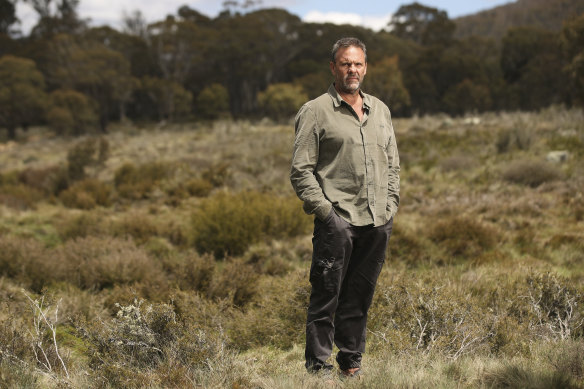
In 2018, the Australia Academy of Science hosted a conference of 145 experts and stakeholders to consider and outline the damage caused by the horses and the need for their eradication.
They sent an open letter to the NSW government detailing their concerns.
About that time, it was estimated that only 50 southern corroboree frogs remained in their alpine habitat in the national park.
Wiradjuri man and alpine river guide Richard Swain, a campaigner for the Invasive Species Council, said we can either have a horse park or a national park but we can’t have both.

Richard Swain of the Invasive Species Council, at the horse-damaged bog at Peppercorn Creek, Long Plain.Credit:Alex Ellinghausen
Soon after, I visited and saw one section of that habitat to find it fenced off by National Parks officers seeking to preserve a sliver of what should have been pristine wilderness from feral horses.
Loading
Even the RSPCA agrees that the most humane way of dealing with the animals would be to shoot them in the park rather than risk the trauma and potential for injury attendant with capturing them and seeking to rehome them or euthanise them elsewhere.
So what did the government do? Bowing to the demands of former Nationals leader John Barilaro and a small but effective horse lobby, it passed the so-called Brumby Bill protecting the pests on the grounds of cultural heritage.
A later compromise led to an agreement to cull most of the ferals, but to maintain a herd of 3000, again on ill-defined cultural heritage grounds.
Today we have the absurd situation where professional shooters are flying through the park in helicopters culling deer, pigs and goats while studiously avoiding the feral horses that are causing the bulk of the damage to the high-country’s fragile headwaters.
Swain is right. We either surrender the park to the horses entirely; or we remove them entirely.
To maintain them in the park would be to damage it pointlessly, and it would see the need for shooters patrolling it endlessly, slaughtering thousands more horses than would otherwise have been killed in a fast and effective intervention.
A guide to the environment, what’s happening to it, what’s being done about it and what it means for the future. Sign up to our fortnightly Clear Air newsletter here.









 Add Category
Add Category